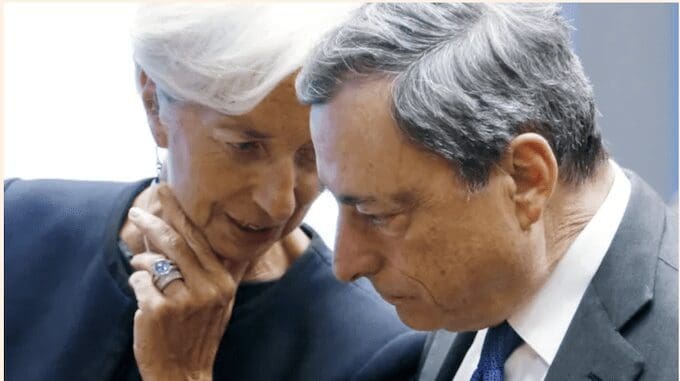In this opinion piece for the Financial Times, Eric Lonergan says that one potential solution central banks around the world should consider to avoid or escape the next recession is to just create money and provide it directly as quantitative easing for the people as suggested by economist Frances Coppola in her book The Case for People’s Quantitative Easing. — Scott Santens, Editor, BIT
In the past, central banks set the price of money using interest rates. In the future, it seems, they will be giving it away. This week the US Federal Reserve reduced interest rates by a quarter of a percentage point to 2.25 per cent.
The chairman of the Fed, Jay Powell, did an admirable job of presenting it as business as usual. But the world of central banking is entering uncharted and potentially treacherous territory. The next phase will require great political skill and intellectual bravery.
With interest rates currently positive, the US looks like an anomaly. In the eurozone, Switzerland, Japan and Scandinavia, official interest rates are negative. Considering the fact that in past recessions the Fed has reduced interest rates by 4 to 5 percentage points, this prospect may not be far away for the US, too.
The very idea of negative interest rates is confusing to most people, and many economists believe that the effects are counter-productive. Central bankers are quick to point out that they have developed a range of tools since the 2008 crisis, with technocratic and inelegant names such as “forward guidance” and “quantitative easing”.
These involve attempts to reduce interest rates. Forward guidance aims to keep interest rates low for longer, and QE is an attempt to use asset purchases to reduce the interest rate on government debt, which is a reference point for long-term borrowing by the private sector. Either way, the problem is the same. When interest rates are already this low, further reductions are ineffective.
So where next for monetary policy? One option is to pass the baton to the fiscal authorities. Last week, Mario Draghi, president of the European Central Bank, suggested as much, stating that it was “unquestionable” that fiscal measures would be required if the eurozone economy deteriorates further. Olaf Scholz, the German finance minister, promptly poured cold water on his suggestion. Imminent support from fiscal policy looks like wishful thinking.
If interest rates are a spent force, and finance ministries unreliable partners, who will save the day? And how, if the current global trade recession turns into something more pernicious? Three novel proposals are gaining support, all of which involve giving people money.
The first, which literally involves central banks posting cheques to households, is detailed in a superb new book, The Case for People’s Quantitative Easing by the economist Frances Coppola. The logic is compelling. The Australian government sent households money during the financial crisis, and Australia avoided recession. Under Ms Coppola’s proposals, the central bank would finance the transfers by creating electronic money, as it does with QE. One problem with this common sense idea is its simplicity, which rarely appeals to economists charged with taking important decisions. Another challenge is legal and administrative. Certainly in the US and UK, such a policy would probably require new legislation, although not in the eurozone. So far, only the Czech central bank has been indicated it might adopt this policy if and when the next recession strikes. Innovation often comes from surprising sources.
Another policy, already being practised by the Bank of Japan, and recently advocated by a fund manager at the investment firm, BlackRock, is that central banks consider giving money to the owners of the stock market by buying equities. Unsurprisingly, many balk at the idea that shareholders are the most deserving beneficiaries of central bank largesse. A more benign take is that higher equity prices would encourage firms to increase investment spending.
The most intriguing and practically viable idea of all is emerging from the least likely of sources, the ECB: so-called targeted long-term refinancing operations. In straightforward terms, this is a policy of dual interest rates which involves giving money to both borrowers and savers. In contrast to the other monetary innovations adopted since the crisis, dual interest rates are almost certain to raise spending and economic activity. How do they work? In any economy, there are two interest rates that really matter to households: the interest rate at which they borrow and the rate they are paid on their savings. One of the problems with reducing interest rates, and with negative interest rates in particular, is that households suffer a decline in interest income on savings.
So what if the central bank decides to reduce the interest rate that borrowers have to pay on loans and raises the interest rate households receive on their savings? The ECB’s programme provides the means to do precisely this. They can cut the interest rate on which they lend to banks, subject to these loans being extended to the private sector, and they can raise the interest rate paid on deposits. The evidence from economic history, and simple logic, suggests that if you boost household income in this way economies will recover.
If the eurozone economy continues to weaken significantly, Christine Lagarde, the incoming ECB president, will face an interesting set of choices. She could have the best of all possible jobs — giving people money. But institutional resistance to simple, transparent and direct monetary solutions appears to be such, that in doing so, she will also face the greatest political challenge of her career.
The writer is a macro fund manager at M&G Prudential





















